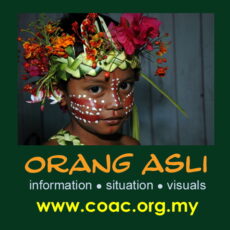With support from Partners of Community Organisations (PACOS), the Asia Indigenous Peoples Pact Foundation (AIPP) and the Center for Orang Asli Concerns (COAC), Jaringan Orang Asal SeMalaysia (JOAS) organized a 2-day community-level UNDRIP training at Kampung Parik, Kelantan on 2-3 May 2014.
The UNDRIP Training in Kelantan was a follow-up action for the Peninsula’s trainers – namely, Angah from Kelantan and Zin from Pahang – who had attended a 4-day Training of Trainers (TOT) session in Miri last March. The objective was on understanding and using the United Nations Declaration on the Rights of Indigenous Peoples.
The activities at the JOAS mini-centre in Kampung Parik (RPS Kuala Betis) were aimed at promoting and demonstrating how the UNDRIP can be practically used to defend Orang Asli rights at the community level.
The trainers and participants
The programme was supervised by Claudia Lasimbang (aka Yoggie) from PACOS in Sabah who had also conducted the Miri TOT and had given much support for Angah and Zin in terms of planning and facilitation skills. Members of the COAC team were the main documenters where pictures and videos were taken throughout the training. Yusri, as vice-president of JOAS for Semenanjung Malaysia, represented the JOAS secretariat.
The participants were from the Temiar and Mendriq subgroups from 12 regions: Kampung Anggek, Kampung Depak, Kampung Parik, Kuala Lah, Kuala Woh, Pos Balar, Pos Ber, Pos Bihai, Pos Bulat, Pos Simpoh, Pos Tohoi and Lojing.
Day One
The morning session on day one started off with Petta, a ceremony to ask for blessings from the Nyeuk Aluij (Creator) led by one of the community leaders, Arom Asir. The session was followed by self-introduction by the representatives according to region. Many shared about wanting to learn more about UNDRIP and how to apply it properly.
After the ice-breaking session, role-playing was the next activity in which participants had to confront “land-grabbers” and show how they would apply the principles and articles from the UNDRIP during the confrontation. This activity was aimed to show the participants how to anticipate questions and to expose their strengths and shortfalls when it came to defending their rights, especially of their traditional territories.
Day-one ended with community mapping of each region and sharing of issues taking place in their region. This activity helped the trainers, especially Yoggie, to have a better understanding of the regions and so be able to conduct a more comprehensive assessment of their needs so that future trainings can be improved.
However, it was observed that there was only one woman – Nora from Kampung Anggek – took part in the training for the first day. The other women were mainly in the kitchen busy preparing meals for the 20 other participants or doing other chores.
Women to the Fore
The second day set a new milestone when the women began to participate actively in the training. Despite the need to juggle the time between cooking and the training, the women’s group managed to take turns to sit in for discussions and plan for their role-play activity. It took some encouragement and motivation from the facilitators however before the dozen women or so were confident to participate actively.
For their role-play activity, the women decided to play out the issue of ‘Ladang Rakyat’ – the Kelantan state government’s so-called development plan to ‘give’ Orang Asli agricultural development but take away much of their traditional territories and their rights. Many of them had showed confidence during the confrontation by speaking out their stance against the ‘land-grabbers’.
Issues close to the heart
The last module for the training involved the participants making presentations on four topics – logging, mining, ladang rakyat and education. Education proved to be the hottest topic when the participants spent more than an hour during the Q & A session.
Many showed great concern and dissatisfaction when it came to the infrastructure and quality of education for their children. The number of participants who attended sessions on the second day swelled to more than 30 when more women got themselves involved.
Sewang, evaluation and a spiritual send-off
The final night ended with a sewang, the the traditional sing-dance of the Temiar people and for most other Orang Asli groups. The venue was a temporary sewang house specifically built and decorated for this event under the supervision of the local-level coordinator Jamali.
But before the sewang proper started, the participants decided to put up another impromptu role-play for the benefit of the non-participants who had come to join in the sewang on the final night. Such was the effectiveness and attrctiveness of the role-plays they had earlier.
Then followed a 25-minute medley of sewang tunes sung by 4 of the participants. These spirit songs were sung to the melodic accompaniment of bamboo stampers and women choruses. The trainers and others then joined in the dance.
After a final wrap-up by coordinators the next morning, Arom Asir (aka Pakcik Arom) conducted another Petta ceremony to ask for blessings and for securing a safe journey home for all who came from afar. This act further reinforced the principles of the UNDRIP, especially Article No. 12 which states that indigenous peoples have the right to practice their own traditions, culture and religion.
Report by Koong Hui Yein
JOAS Secretariat (Semenanjung)
6 May 2014
Click on the link to see the full photo album of the event: JOAS UNDRIP training at Kg Parik
[Photography by Colin Nicholas, Ricklend Christopher, Greg Pernia, Koong Hui Yein.]

